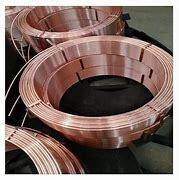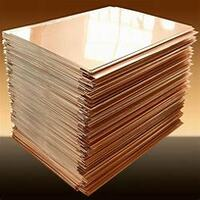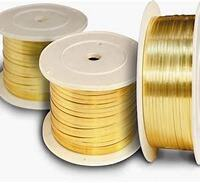1. Introduction
Just 24 hours ago, global copper prices surged past $8,900 per metric ton amid supply chain disruptions in Chile and rising demand from renewable energy infrastructure. This spike has reignited interest in copper-based components like rods, strips, and pipes—not just for their conductivity, but for their versatility across industries.

Whether you’re grounding an electrical system, welding copper parts, or installing AC lines, understanding the differences between copper rod types is essential. In this guide, we break down seven critical categories of copper rods and strips, comparing materials, uses, and real-world performance.
2. Copper Earth Rods: Grounding Made Reliable
Copper earth rods—also called earthing rod copper or ground rod copper—are essential for safe electrical grounding. Two main types dominate the market: solid copper rods and copper-bonded or copper-clad variants.
Solid copper rods offer superior corrosion resistance but come at a premium price. In contrast, copper bonded earthing rods (made with a steel core and thick copper layer) balance cost and durability. Similarly, copper clad steel ground rods and copper clad earth rods use electroplating or metallurgical bonding to fuse copper onto steel, offering high tensile strength with decent conductivity.
- Solid copper earth rod: Best for corrosive soils, but expensive
- Copper bonded steel: Cost-effective, widely used in commercial projects
- Copper clad steel earth rod: Good conductivity, ideal for rocky terrain
Earthing rod price varies significantly—solid copper can cost 2–3x more than copper-bonded alternatives. For most residential applications, copper bonded ground rods deliver the best value.
3. Copper Brazing and Welding Rods: Joining Copper Like a Pro
When it comes to joining copper components, not all rods are equal. Copper brazing rod and copper welding rod serve different purposes.
Copper to copper brazing rods typically contain phosphorus or silver alloys, enabling strong, leak-proof joints without melting the base metal—ideal for plumbing and HVAC. On the other hand, copper rod for welding is used in specialized applications like electrical busbars or motor windings, often requiring inert gas shielding.

For DIYers, copper to copper welding rod options are limited; most prefer brazing due to lower heat requirements. Remember: welding rod copper isn’t the same as filler rods for steel—always match the alloy to your base metal.
4. Copper Round Bars vs. Flat Strips: Shape Matters
Beyond rods, flat copper forms like copper strip, flat copper strip, and copper beryllium strip serve niche roles. A copper round bar (or round bar copper) is commonly used in machining, while thin copper strips power electronics and grounding straps.
Beryllium copper strip and copper alloy strip offer enhanced strength and spring properties—perfect for connectors and switches. Meanwhile, nickel plated copper strip resists oxidation in high-humidity environments.
Common sizes like 1mm copper strip or copper earth strip 25x3mm are widely stocked. Need flexibility? Look for flexible copper bus bar or flexible copper bar for tight installations.
5. Stripping Copper Wire: Scrap, Recycling, and Safety
With copper prices climbing, many are asking: is stripping copper wire worth it? Absolutely—but only if done right.
The best way to strip copper wire avoids burning (which releases toxic fumes and degrades value). Instead, use mechanical strippers or automated machines. Burning copper wire for scrap is illegal in many areas and reduces resale value.
- Best way to strip copper cable: Use a rotary wire stripper
- Fast way to strip copper wire: Industrial cable peelers for bulk jobs
- Stripping wire for recycling: Separate insulation cleanly to maximize payout

Searches like ‘copper strip near me’ or ‘roll of copper strip’ often lead to scrap yards or metal suppliers—always compare copper strip price per kg before selling.
6. Copper Pipes and Tubing: Not Rods, But Related
While not rods, copper pipework shares material traits and market trends. Aircon copper pipe, 15mm copper tube, and 22mm copper pipe are staples in HVAC and plumbing.
Air conditioning copper pipe must be oxygen-free to prevent internal corrosion. Prices for ac copper pipe fluctuate with LME copper rates—recent quotes show aircon copper pipe price up 12% month-over-month.
Pro tip: When bending copper pipe, use a spring bender to avoid kinks. And always clean copper pipe before soldering—resoldering copper pipe joints fails if oxidation isn’t removed.
7. Pricing and Sourcing Trends in 2024
Copper rod price and copper ingot price are tightly linked to global markets. As of this week, expect to pay $9–$12/kg for high-purity rod copper, while copper bonded variants run $4–$6/kg.
For strips, copper strip price ranges from $15–$30/kg depending on thickness and alloy. Beryllium copper strip commands a premium due to its aerospace and defense uses.
If you’re sourcing copper bars for sale or copper tubing fittings, check local distributors for bulk discounts. And remember: copper bus bar and cu bars are often sold by cross-section (e.g., 1oz copper price per linear foot).
8. Conclusion
From earthing rods to brazing fillers and flat strips, copper’s adaptability makes it indispensable. Whether you need a copper clad steel earth rod for grounding or a roll of thin copper strips for electronics, matching the right form to your application saves money and boosts performance. With copper prices volatile but demand steady, knowing these distinctions gives you a serious edge—whether you’re building, repairing, or recycling.
Our Website founded on October 17, 2012, is a high-tech enterprise committed to the research and development, production, processing, sales and technical services of ceramic relative materials such as 7. Our products includes but not limited to Boron Carbide Ceramic Products, Boron Nitride Ceramic Products, Silicon Carbide Ceramic Products, Silicon Nitride Ceramic Products, Zirconium Dioxide Ceramic Products, etc. If you are interested, please feel free to contact us.

